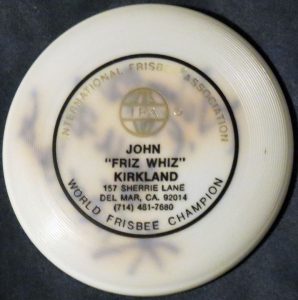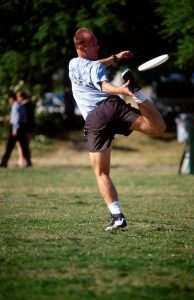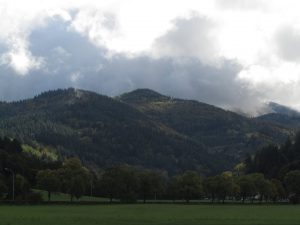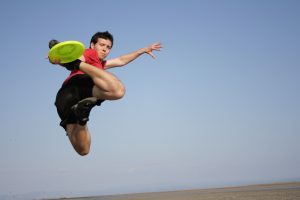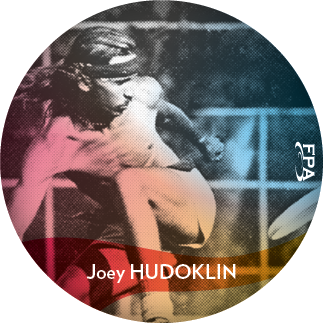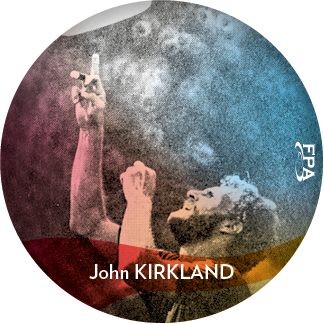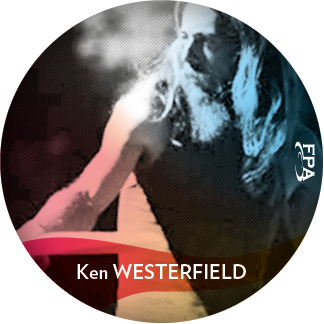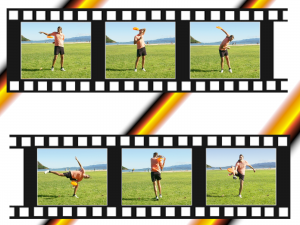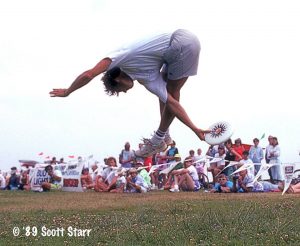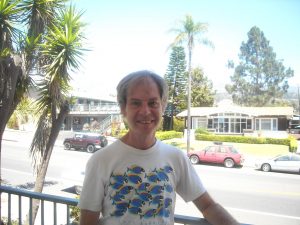
Alex Cornwell
For this post we have a guest writer, Alex Cornwell. Alex is one of the many, long time Frisbee Players in New York City. Anyone who attended FPA Worlds in 2016 probably met Alex. Being in the New York Jamily has touched Alex’s life. In 2016 he was inspired to learn that the Jamily extends far beyond New York. In this article, Alex shares his love and appreciation for Frisbee with us and the world. Thanks, Alex!
Frisbee: just the word invokes feelings of summer, beach, camp, park, etc. We picture a Frisbee and imagine it soaring in the sky. What makes it so magical? Dr. Stancil Johnson, who wrote one of the classic treatises on the sport of Frisbee: “A Practitioner’s Manual and Definitive Treatise”, declared, “When a ball dreams it dreams it is a Frisbee.” Freestyle Hall of Fame inductee, Dan “The Stork” Roddick, riffing off Dr. Johnson’s comment, declared “when a Frisbee dreams, it dreams of being Freestyled.”
This article will delve into how I got my start and my personal reflections about the Freestyle Frisbee scene in general and particularly in New York. I have been very blessed to be part of this wonderful community for about 10 years. I have been playing Frisbee for over 40 years, but the last 10 years have been just a revelation.
When I was in high school, I played quite a bit but we never had anybody that was that good. Collectively, we had 5-6 throws and 3-4 catches and that was it. There were no other moves. We did play all the time however. Consequently, we got the “Heaver Bug” as opposed to the “Jammer Bug.” I, for one, was hooked. I played on and off through college and beyond.
For years in Hastings where I live, I have been known as “Frisbee” or “Frisbee dude” or something similar. I was the best Frisbee player, or close to it wherever I played. Now, that is not always the case! Occasionally, I’d join in an Ultimate game at SUNY Purchase or play at the Clearwater Festival. There, I was in my element – just another ordinary good player!
I started going to the Sheep Meadow in Central Park, New York about 15 years ago just heaving with anyone who was decent. The Meadow is one of the Meccas of the Freestyle Frisbee World. The Sheep Meadow is located on the West Side of the Park and is about 15 acres; so named because sheep roamed in the area years ago. Central Park’s website notes, “In the 1960s and 70s, Sheep Meadow became the scene for large-scale concerts, the televised landing on the moon, peace rallies and anti-Vietnam War demonstrations. But these events, and the lack of management and maintenance, led to the lawn becoming severely eroded — a virtual dust bowl. In 1980, it was restored and has been maintained by The Central Park Conservancy ever since”. The New York Park’s Commission, in its infinite wisdom, refurbished the area. Now it’s beautiful.
It is here, by the manhole cover, in the middle of the Meadow, where we congregate every Thursday for a gathering called “All Star Thursday” (A*T), as long as the weather is nice and the Meadow is open. When I first started going to the Meadow, I didn’t even feel comfortable being in the same space as the legends. They were so far beyond me in ability I was astonished. Now, I am one of the gang, albeit less skilled.
On any given day, the Meadow is filled with hundreds of people. Many groups bring a picnic or just hang out. The sport that people play the most is…you guessed it…Frisbee. Yet, as one who has witnessed the elite in the sport, it is still amazing to me that they not more recognized. Not many even pay much attention to them, although the level of play is consistently astonishing. In 2016, the Freestyle Frisbee World Championships were in Brooklyn, and the Meadow had one of the greatest assemblages of freestyle Frisbee talent. At one point there was a jam of about 15 people which was EPIC. Yet not many non-freestylers watched. If, on the other hand, freestyle Frisbee was a more popular sport and the crème de la crème were out, there would be a larger number of fans watching and the players would be much more recognizable. That doesn’t stop the freestylers from coming out though. They are diehards – even in bad weather.
One thing I have noted many times and others have commented on is the closeness of the community. The spirit of inclusivity is an important component. There is a phrase that the jamming community uses, “Jamily.” Jammers are all around the world, and anywhere there are jammers, there are family members. It is really one big family. Most people who attended the 2016 FPA Worlds were not staying in a hotel or even an Airbnb. They stayed in people’s homes.
I was in Virginia recently for the Virginia States and the whole family concept was really brought home. The love for the people who set up was palpable. And the love of the organizers towards the participants, some of whom were the same, was also obvious.
The community is the same at the Meadow. Freestylers encourage each other and push them to bigger and better feats of Frisbee madness. If someone has made several unbelievable moves in a row – but hasn’t either caught or passed the Frisbee – a common refrain is, “Now what?” Another common refrain when someone pulls a new move is, “Look at you now!” Another one is, “waka-waka” for an especially incredible move. Other expressions of support and/or challenge are prevalent. This sense of encouragement is a very important component of the whole scene.
One important occasion is the awarding of the Gamboa. It is a small statue with a hand holding a Frisbee in the nail-delay position. After a consideration of a few regulars including the previous winner if present and a brief ceremony, the Gamboa is presented to the person who displays the best technique following a brief speech. This feeling of spreading the jam not only is translated to the veterans but, more importantly, to the newbies. The concept of Spread the Jam is crucial.
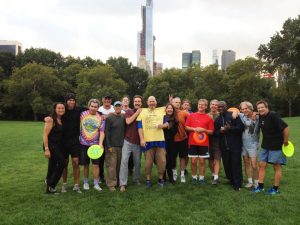
Photo by Rob Fried
Another aspect is the Yella phenomenon. Someone who is Yella has been absent from the scene for a week or more. T-shirts have been made with the inscription “Who is Yella”. There is also a heckler-in-chief, often one on the disabled list, not a fun place to be by the way. His or her role is to gently poke fun at the participants challenging them to more elaborate moves. The goal once again is to bring out the best.
The community is way beyond all the physical stuff though. The community, as I mentioned, is really one big family. When people need a place to stay, a bed magically appears in a Freestyler’s house. Many times a guest jammer, either announced or as a “Mystery Guest”, will come to the Meadow and be greeted warmly by the people there. And then the jam gets spread! When tragedy hits, as it inevitably does, the community is there to support each other. When a beloved member of the community passed away recently, the first one to do so, prayers went up before and after. People shared reminiscences and pictures online and together. And during the freestyle Worlds in 2016, there was a brief ceremony by the manhole cover. There was someone, a 19 year old, who had only been in the Meadow a couple of times. She commented on the closeness of the community. A couple of weeks after she got her first real taste of ZZzzs. She was already dreaming about it. She’s caught the “Freestyle Fever” and now has begun competing and is doing very well in such a short time.
My favorite thing with Frisbee is teaching. This is my small way of Spreading the Jam. Throwing is what I do best. It’s very gratifying to see a kid who at first can’t throw very well, and then with a pointer or two they improve dramatically. When I was in VA, with the help of a jammer, we taught a kid to catch a couple of catches for the first time. And as I point out to the younguns, many of the moves that are common now were not invented yet when I was their age. Kerry Kolmar, one of the elites, states in his article, Falling into Frisbee “the truth about Frisbee is that its greatest gift is not just enjoyed by those of us who have mastered it, but also reflected in the joy that it brings to people the first time they try it. Watch a child throw a Frisbee for the first time and you’ll see what I mean. In its simple, miraculous design, Fred Morrison gave the world a universal tool for communicating.”
So where does this leave us? Back at the beginning. With the beauty of the Frisbee. Spreading the joy of Frisbee. Spreading the jam. When we dream, we dream of playing Frisbee!



